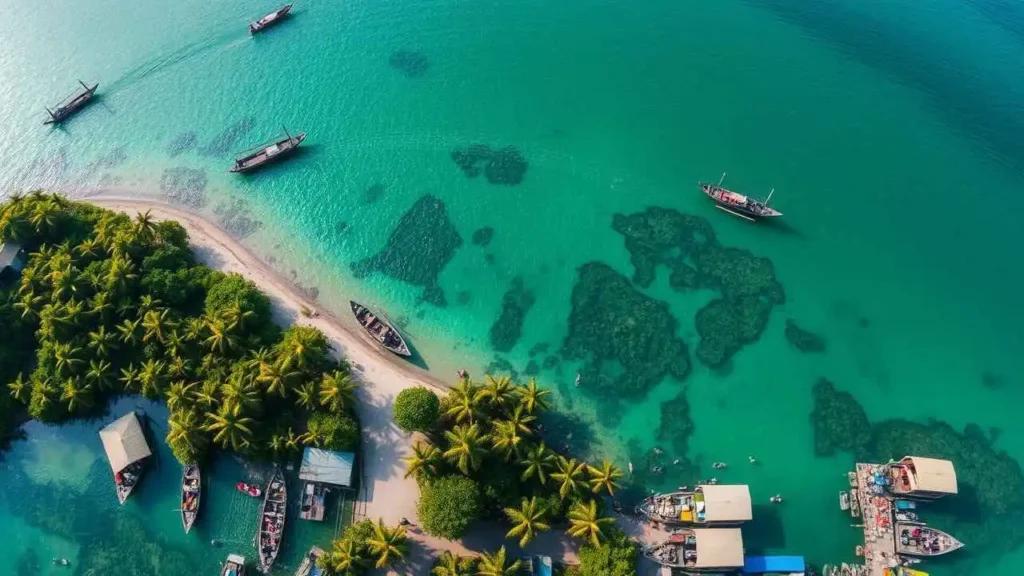
Phu Quoc: Unveiling Vietnam’s Emerald Island Paradise
There’s a certain magic that calls to us when we think of island escapes – a promise of sun-drenched beaches, crystal-clear waters, and a slower pace of life. Vietnam, a country celebrated for its vibrant culture and stunning landscapes, holds its own island gem: Phu Quoc. Often dubbed the “Emerald Island” for its lush interior and surrounding azure waters, Phu Quoc offers a captivating blend of natural beauty, rich history, and burgeoning tourism. We recently had the opportunity to explore this enchanting destination, and we’re eager to share what we discovered about its location, countless attractions, how to navigate its shores, and the delicious delights that await.
Where in the World is Phu Quoc?
Our journey to understanding Phu Quoc began with locating it on the map. Situated in the Gulf of Thailand, off the southwestern coast of Vietnam, Phu Quoc is actually closer to Cambodia than mainland Vietnam. It is the largest island in Vietnam, covering approximately 574 square kilometers. Administratively, it is part of Kien Giang Province. Its strategic location has played a role in its historical significance and its growing accessibility.
Getting to Phu Quoc has become increasingly convenient. The island boasts an international airport (Phu Quoc International Airport – PQC), which handles direct flights from major Vietnamese cities like Ho Chi Minh City and Hanoi, as well as a growing number of international destinations. For those preferring a scenic route or traveling from nearby coastal towns like Ha Tien or Rach Gia, ferries and speedboats offer regular services. We found that flying was the quickest option, landing us right in the heart of the island’s evolving landscape.
A Tapestry of Sights: Exploring Phu Quoc’s Attractions
Once on the island, we quickly realized that Phu Quoc is far more than just beaches, although its coastline is undoubtedly a major draw. The island offers a diverse range of sights and experiences, catering to different interests – from nature lovers and history buffs to foodies and adventure seekers. Here are some of the highlights we explored:
- Beaches: The undisputed kings of Phu Quoc’s attractions.
- Long Beach (Bai Truong): Stretching over 20 kilometers along the west coast, this is the most developed and popular beach area, lined with resorts, restaurants, and bars. Perfect for sunset views and easy access to amenities.
- Sao Beach (Bai Sao): Located on the southeast coast, this beach is famous for its powdery white sand, calm turquoise waters, and swaying palm trees. It feels like a postcard come to life.
- Khem Beach (Bai Khem): Another stunning white sand beach near Sao Beach, offering clear waters and a more secluded feel than Long Beach, though development is increasing here.
- Ong Lang Beach (Bai Ong Lang): Found on the northwest coast, this beach offers a more laid-back, natural beauty, with rocky outcrops and golden sand stretches. A great spot for a quieter escape.
- Natural Wonders: The island’s interior is surprisingly rugged and green.
- Phu Quoc National Park: UNESCO recognized it as a World Biosphere Reserve. Covering over half the island, the park offers hiking trails (though some require a guide) through dense forest, leading to waterfalls and diverse flora and fauna.
- Suoi Tranh Waterfall: A popular spot during the wet season, this small waterfall offers pools for swimming and a pleasant walking trail through the forest.
- Cultural & Historical Sites: Phu Quoc has a fascinating, albeit sometimes difficult, past.
- Phu Quoc Prison (Coconut Prison): A sobering historical site that served as a prison during the French colonial era and the Vietnam War. It offers insight into the struggles and resilience of Vietnamese people.
- Dinh Cau Rock Temple (Cau Temple): A charming temple built on a rocky outcrop at the mouth of Duong Dong river. It’s a significant spiritual site for fishermen and offers panoramic views, especially at sunset.
- Traditional Industries: Visiting a local pepper farm (Ho Tieu Phu Quoc – Phu Quoc pepper is famous), a fish sauce factory (Nuoc Mam Phu Quoc – a key ingredient in Vietnamese cuisine), or a small pearl farm provides fascinating insight into the island’s traditional economy.
- Modern Attractions: The island has embraced tourism with large-scale developments.
- Sun World Hon Thom Nature Park Cable Car: The world’s longest non-stop sea cable car connects Phu Quoc to Hon Thom (Pineapple Island). The ride offers breathtaking aerial views of the archipelago. Hon Thom also features a water park and beach area.
- Vinpearl Land & Safari: A massive entertainment complex in the north of the island, featuring a theme park, water park, and a semi-wildlife park.
This diverse array meant we could spend our mornings lounging on a beach, our afternoons exploring a historical site or hiking through the park, and our evenings soaking in the atmosphere of the bustling night market.
Navigating the Island: Local Transportation





